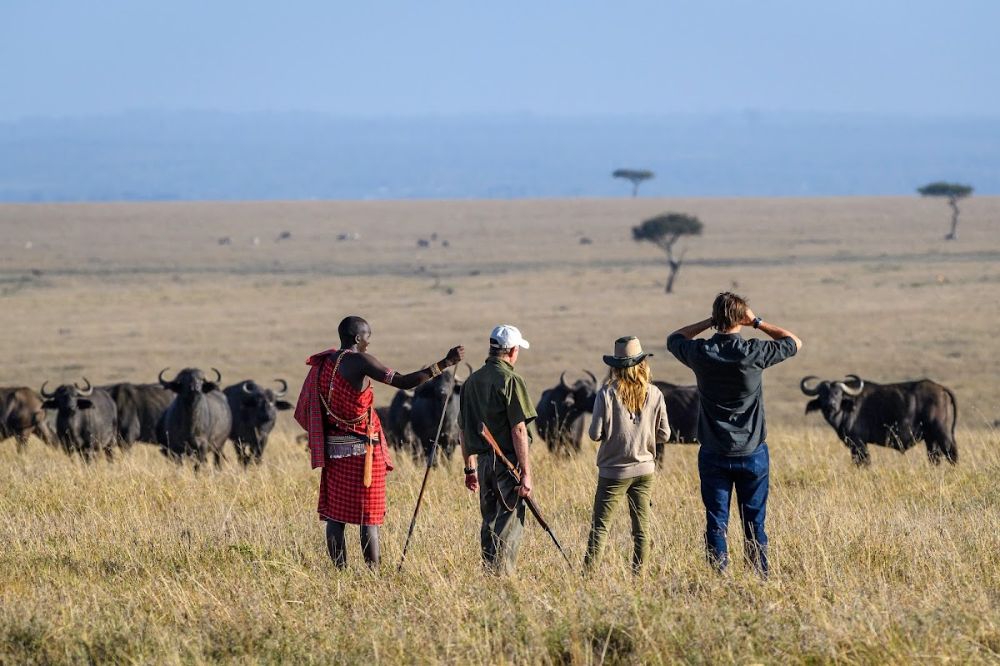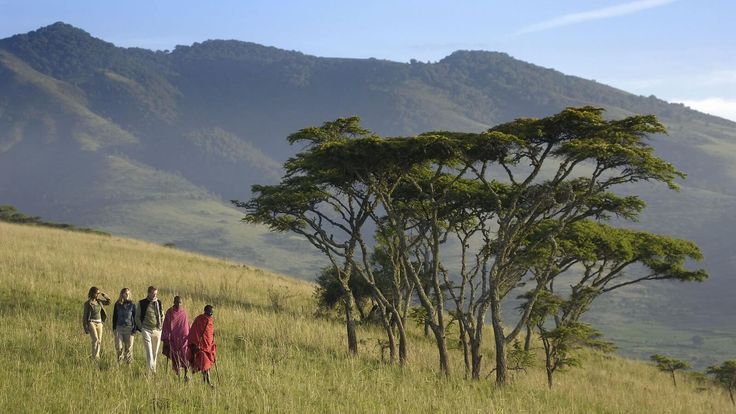Are There Walking Safaris in Tanzania?
Yes—Tanzania offers some of the finest walking safaris in Africa. These experiences take you beyond traditional vehicle-based game drives into intimate exploration of landscapes, wildlife tracking, and local culture—all on foot. If you’re seeking discovery that awakens your senses and deepens your connection to the bush, a walking safari with Great Migration Adventure is an unforgettable option.
What Is a Walking Safari?

A walking safari involves guided exploration of protected areas on foot, typically in small groups (4–6 people), accompanied by licensed, armed guides. These outings range from short nature walks near camp to multi-day wilderness trekking with fly camps. On foot, you gain close access to tracks, insects, birds, plants, and wildlife behavior rarely visible from vehicles. Walking safaris emphasize immersive observation and responsible, low-impact tourism.
Why Choose a Walking Safari?
-
Full sensory immersion: Feel the bush beneath your feet, hear subtle rustles, and smell the landscape.
-
Tracking insight: Guides teach you to read spoor, droppings, plant uses, and animal behavior up close.
-
Small wildlife discovery: Enjoy encounters with birds, insects, reptiles, and small mammals usually missed in vehicles.
-
Wild, vehicle-free zones: Many walking areas are off-limits to 4×4 vehicles, preserving the sense of untouched wilderness.
-
Eco‑friendly travel: Less noise and disturbance, lighter environmental footprint.
Top Walking Safari Destinations in Tanzania
1. Selous Game Reserve (Nyerere National Park)
Tanzania’s southern wildlands host some of the most immersive walking safaris. From bush camps along the Rufiji River, walking safaris include tracking elephants, wild dogs, lions, hippos, and abundant birdlife. Boat cruises often complement walking routes. Best from June to October during the dry season.
2. Ruaha National Park
Ruaha offers rugged, remote walking through baobab-dotted forest and sand riverbeds. Here you may follow elephant paths, spot buffalo herds from a safe distance, and encounter predators on foot. Fly‑camping options allow overnight treks under the stars.
3. Serengeti National Park & Fringe Concessions
While most of the Serengeti prohibits walking safaris, private concessions like Loliondo and Grumeti offer multi-day walks in wilderness zones. These programs often include fly-camps, and guides are deeply knowledgeable about animal tracking, migration rhythms, and seasonal ecology.
4. Tarangire National Park
Ancient baobab forests and elephant-rich plains make Tarangire a superb walking option. Guided walks explore riverine woodlands and open savannahs, sometimes ending in bush breakfasts. Many camps offer walking add-ons alongside game drives. Best visited June–October.
5. Arusha National Park
Located near Arusha town, this small park offers accessible walking trails around the Momella Lakes, micro-forest zones, and Mount Meru Crater rim. Safaris here feature buffalo, giraffe, zebu, and abundant birdlife. A good entry point for those new to walking safaris.
6. Mahale Mountains National Park
Hosted on Lake Tanganyika’s shores, Mahale has no roads and is accessible only by boat or foot. Walking here includes forest treks and chimpanzee tracking. Trails culminate at stunning lake viewpoints and waterfalls—with rare flora, birdlife, and primates.
7. Katavi National Park
Among Tanzania’s most remote parks, Katavi delivers true wilderness walking. Expect buffalo congregations, hippo pools, river edge exploration, game tracking, and solitude. Fly-camping enhances the experience. Best walking season runs May–October.
8. Udzungwa Mountains National Park
Part of the Eastern Arc Mountains, Udzungwa is a biodiversity hotspot. Hiking trails range from a few hours to multi-day treks, some leading to waterfalls or primate habitat. As there are no roads inside the park, it must be explored on foot—delivering a rainforest walking safari.
Types of Walking Safaris

Short Bush Walks (1–2 hours)
Ideal for enhancing a game drive itinerary; focus on birding, tracking, plant identification, or small wildlife once you arrive at camp.
Half-Day Walks (2–4 hours)
Deeper exploration around camp or habitat zones. Includes interpretative stops, wildlife tracking, and midday bush break.
Multi-Day Wilderness Walking Safaris
Fly‑camping safaris allowing you to trek 4–6 hours per day across remote landscapes. These are led by experienced guides with full backing logistics—water, meals, and support.
Cultural & Scenic Walks
In areas such as Ngorongoro Highlands (Empakai, Olmoti, Lake Natron) and Lake Eyasi, walking combines scenic crater hikes and Maasai cultural discovery.
What to Expect on a Walking Safari
-
Early starts at dawn, when wildlife is most active.
-
Groups limited to six people, accompanied by licensed armed rangers.
-
Low-impact pace, focusing on interpretation and nature awareness.
-
Weather-adapted gear, including hat, long trousers, closed shoes, and water.
-
Learning focus: guides point out animal tracks, plant uses, birdlife and bush behavior.
-
Wildlife encounters may include elephants, giraffe, zebra, buffalo—always at safe distance—and sometimes predators.
Best Time to Go
-
Dry season (June–October) is ideal: dry trails, optimal visibility, and wildlife gathering around water.
-
Wet/green season (November–March) brings lush scenery and excellent birding—but walking routes may be muddy or restricted.
Sample Walking Safari Itineraries
7-Day Walking & Wildlife Signature Tour
-
Days 1–2: Arrive Arusha; walking safari in Arusha NP and Manyara floodplains.
-
Days 3–4: Fly to Ruaha for walking along the Great Ruaha River and sunset game drives.
-
Days 5–6: Transfer to Selous or Katavi fly‑camp; multi-day walking in floodplains.
-
Day 7: Return to Dar; depart or extend to Zanzibar.
5-Day Serengeti Wilderness Trek
-
Day 1: Arrive Northern Serengeti; camp setup.
-
Days 2–4: Wilderness walking each morning, tracking migration movement and learning bushcraft; includes fly‑camp nights.
-
Day 5: Game drive back to central Serengeti, then fly to Arusha.
Ngorongoro Highlands & Crater Walk & Culture
-
Day 1: Arrive Arusha; short walk around Empakai Crater rim and Maasai village visit.
-
Day 2: Walk up Olmoti Crater trail, descend to Lake Natron area.
-
Day 3: Hike to view flamingos and dramatic Rift landscapes; afternoon crater descent game drive.
Conservation & Ethical Tourism
Walking safaris promote low-impact tourism, benefit remote community camps, and support ranger-based employment. Since visitor numbers are small, impact remains minimal and revenue helps fund park anti-poaching, community health, and education. Great Migration Adventure works with operators committed to TANAPA rules, environmental stewardship, and local partnerships.
Traveler Tips for Walking Safaris
-
Physical fitness: moderate conditioning is recommended; treks may involve uneven ground and mid-morning heat.
-
Pack light: daypack with water, snacks, hat, sunscreen, camera, binoculars.
-
Clothing: neutral tones, closed shoes, long sleeves/pants to protect against sun and insects.
-
Respect guides: follow ranger instructions for safety and wildlife camouflage.
-
Weather flexibility: some heavy rain may restrict walking; alternative vehicle options may be offered.
FAQs
Are walking safaris safe?
Yes—when led by licensed, armed guides in compliance with park regulations. Group sizes remain small for safety.
Can children join?
Many walks suit ages 8+ depending on fitness; family-friendly short walks are offered at certain camps.
Is walking safari expensive?
Costs vary by region: multi-day wilderness treks are premium, while short nature walks add moderate surcharge to lodge packages.
Do I need experience?
No—trained guides support all levels. Some routes are beginner-friendly; others challenge seasoned walkers.
Why Book with Great Migration Adventure?
-
Tailored walking safari itineraries based on your interests — wildlife, culture, terrain.
-
Access to quality operators experienced in walking safari logistics across Tanzania’s parks.
-
Safety assurance and strong guide relationships in all walking zones.
-
Logistics handled: flights, transfers, lodging, walk gear, and permits pre-organized.
-
Conservation commitment: bookings support low-impact tourism and local communities.
Walking safaris in Tanzania offer profound intimacy with nature: the sound of footsteps on grass, the sight of tracks, the hush before a giraffe sighs under an ebony tree. Whether it’s strolling through baobab forest in Tarangire, tracking elephants along Ruaha’s rivers, trekking under the Serengeti sky, or crossing rainforest streams in Mahale or Udzungwa—Tanzania delivers walking safaris that change how you see the wilderness.
With Great Migration Adventure, your journey on foot is seamless, meaningful, and transformative—blending ecology, conservation, and sensory richness into every step.









